February 23, 2024
Top 10 Cutest & Most Adorable Animals in Schönbrunn Zoo
Conservation, Fauna, Guide
This page contains links through which we may earn a small commission should you decide to book a tour from our partner.
Top attractions:
Quick Navigation
Animals of Schönbrunn Zoo
It is no secret that a World-class Zoo like the one in Schönbrunn hosts many iconic and majestic animals from different corners of the planet. Naturally, many visitors seek out those “big-game” species; It is a no-brainer, yet, undoubtedly, interesting. However, my statement would be that these magnificent animals as they are, are not the most interesting inhabitants of the Zoo. Most of the time they simply sleep as they require a lot of rest and moving takes a lot of energy. The most famous example, and probably the most popular animal in Schönbrunn Zoo, Great Panda – notoriously have just 1 hour a day of freetime. So if you come exquisitely to the Zoo of Vienna to see these rare species, it will have to be your lucky day to see Great Pandas moving around their settlement – most likely they’ll be sleeping or eating bamboo somewhere in a corner. For this reason, the feeding timetable of these popular animals is shared publicly. That is your best shot if you come to see the most magnificent animals in Schönbrunn Zoo.
I’ve been frequently visiting Schönbrunn Zoo for a couple of years now and from my experience, less popular species, who are often much smaller, or, simply, lower on the food-chain-pyramid, are much more active and even interactive compared to the top dogs in the house (There are no dogs in Schönbrunn Zoo). In this article, I try to focus on a much less popular, yet much more rewarding species, who often offer a much more intimate and memorable encounter than their big counterparts.
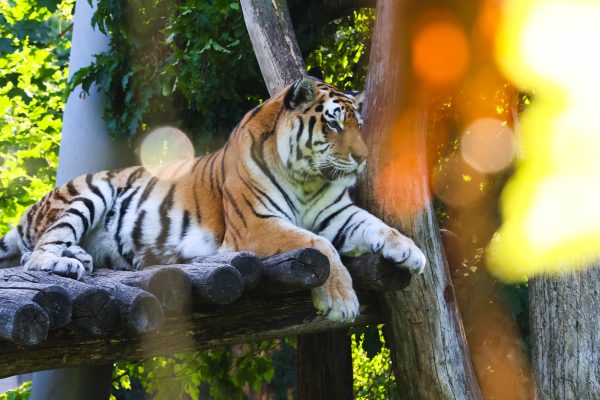

1. Common Dwarf Mongoose
- Status: Least Concern
- Origins: Sub-Saharan Africa
- Location: East Africa House
The Common Dwarf Mongoose, a tiny carnivore from sub-Saharan Africa, showcases remarkable social behavior and ecological importance. These mongooses, measuring 18 to 28 cm / 7 to 11 in and weighing 200 to 350 g / 0.44 to 0.77 lb, live in structured groups dominated by a leading female. Despite their small size, they are known for their boldness, especially in confronting larger predators like venomous snakes.
Adapted to various habitats such as grasslands and bushlands, dwarf mongooses thrive by feeding on insects, spiders, and scorpions, playing a key role in controlling pest populations. Their survival, however, is challenged by natural predators including birds of prey and larger mammals.
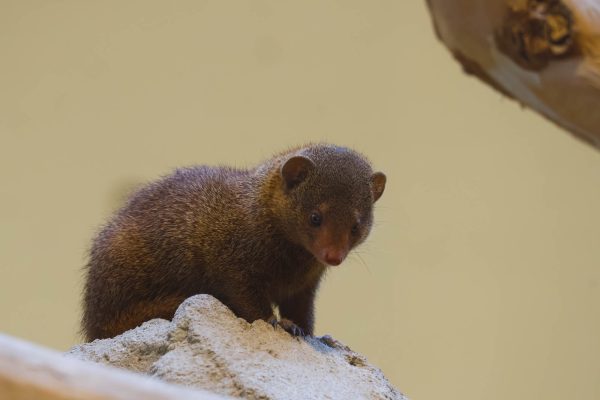
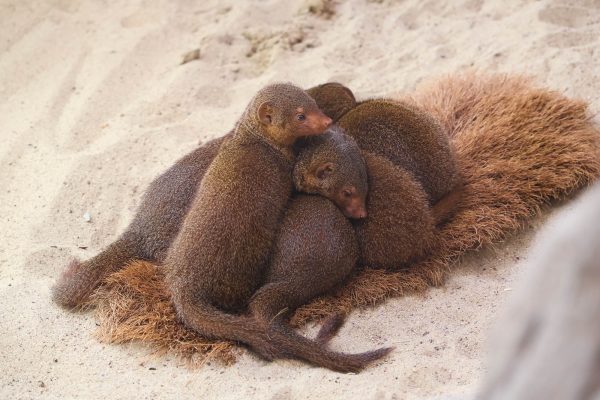
Schönbrunn Zoo’s Dwarf Mongoose exhibit mirrors their natural environment, promoting their inherent behaviors and social dynamics for visitor observation. The exhibit focuses on the species’ diet, social hierarchy, and symbiotic relationships with species like hornbills and monitor lizards, highlighting their significance in the ecosystem. Through education and conservation efforts, the zoo aims to raise awareness about the biodiversity of African ecosystems and the importance of species like the dwarf mongoose in maintaining ecological balance.
2. Red Panda
- Status: Endangered
- Origins: Eastern Himalayas & Southwestern China
- Location: Pandas’ Triangle
The Red Panda, known for its distinctive russet fur and bushy tail, inhabits the temperate forests of the Eastern Himalayas and Southwestern China. Unlike the Giant Panda, with which it shares a common name, the Red Panda is the sole representative of the Ailuridae family, distinguishing itself with a unique ecological role. Weighing between 3 to 6.2 kg / 6.6 to 13.7 lb, this creature, slightly larger than a domestic cat, relies on a diet mainly of bamboo, but it also consumes eggs, birds, and insects, highlighting its omnivorous diet.
Expert climbers, Red Pandas spend the majority of their lives in trees, utilizing their sharp claws and robust limbs to navigate the forest canopy where they find food, rest, and rear their young. However, these enchanting animals are facing significant threats due to habitat loss, fragmentation, and poaching, which have led to their classification as endangered, with less than 10,000 mature individuals remaining in the wild. This stark number underscores the critical need for protective measures.
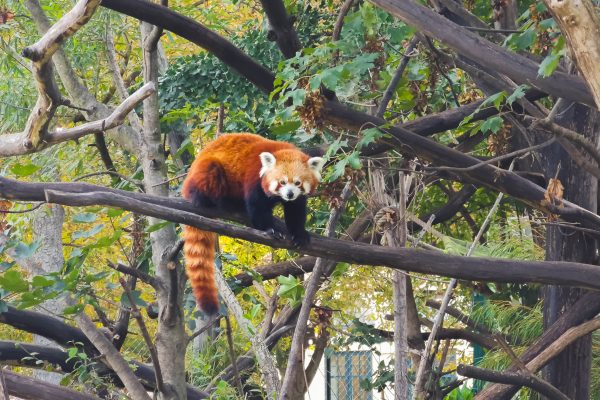
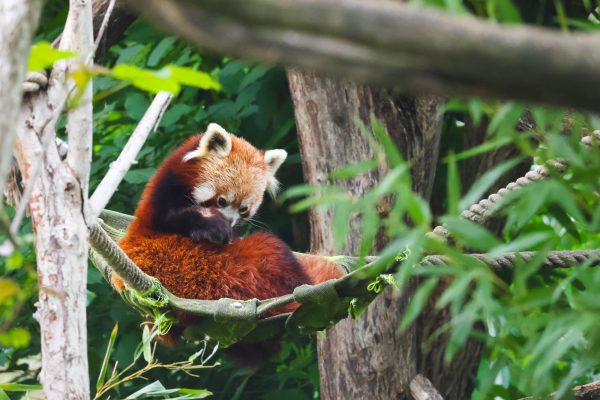
At Schönbrunn Zoo, the habitat for “Mahalia” and “Manjul,” our resident Red Pandas, is crafted to mimic their natural environment as closely as possible, featuring trees for climbing, areas for foraging, and secluded spots for rest. This setup is part of a broader conservation effort that includes participation in a European breeding program involving over 130 zoos, aimed at ensuring the survival of this species. The program addresses the alarming decline in wild populations, primarily attributed to deforestation and poaching.
3. Meerkat
- Status: Least Concern
- Origins: Southern Africa
- Location: Monkey House
The Meerkat, a small yet fascinating member of the mongoose family, thrives in the arid regions of southern Africa, embodying remarkable adaptations for survival in such harsh environments. These sociable mammals, weighing between 720-730 g / 1.58-1.61 lbs and standing 25-35 cm / 9.8-13.8 in tall, demonstrate a versatile diet that ranges from insects to small vertebrates and eggs, underlining their omnivorous nature.
Famed for their intricate social systems, meerkats form groups called “mobs” or “gangs,” with up to 30 members. They adopt communal roles for foraging, predator lookout, and young care. Their two-legged stance for scanning the environment and their cooperative digging for underground tunnels, where they cleverly block their ears to avoid sand, highlight their adaptability and unity.
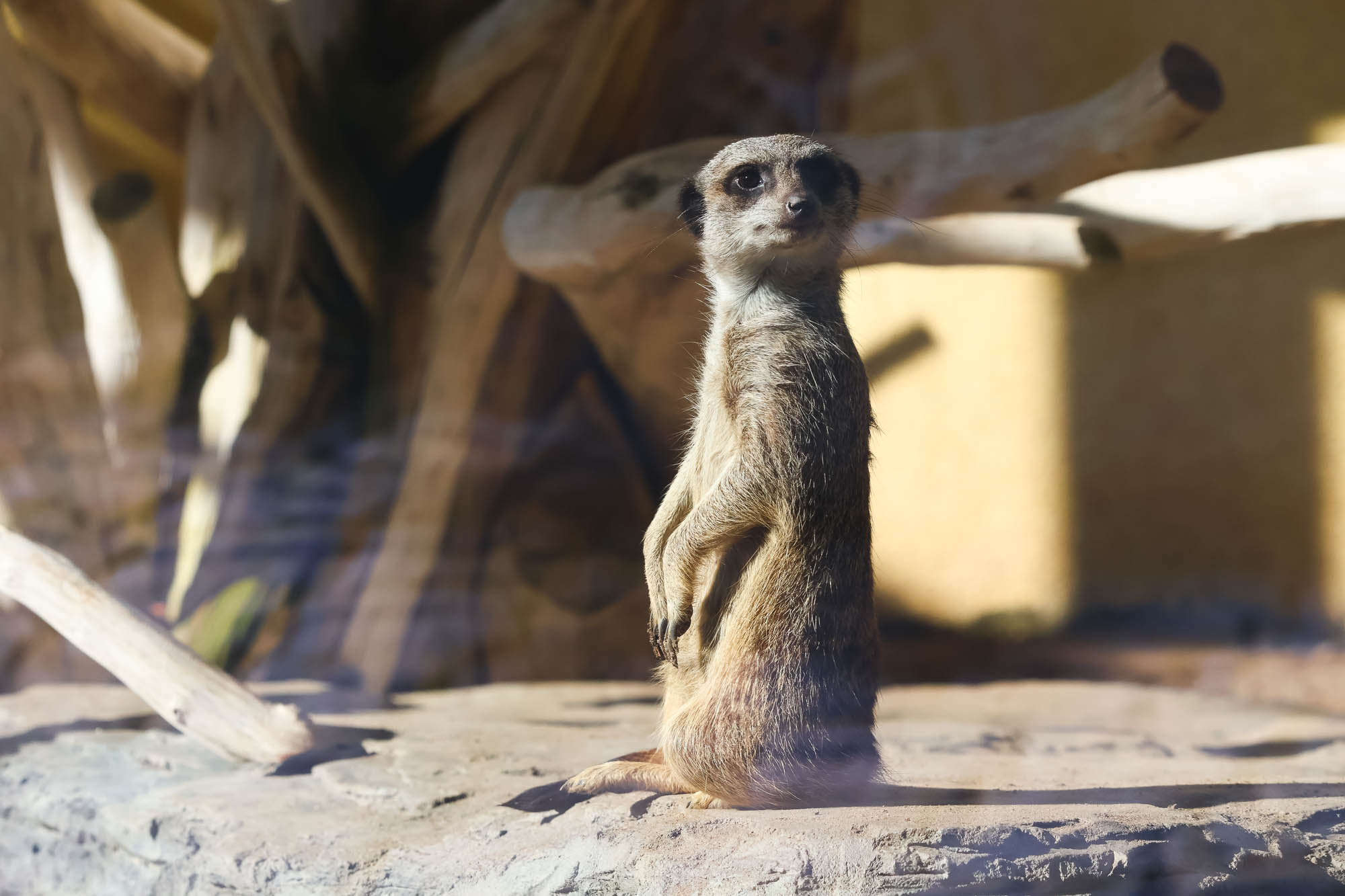
Did you know that Meerkat belong to Mongoose family? Photo by Alis Monte [CC BY-SA 4.0], via Connecting the Dots
Schönbrunn Zoo’s meerkat exhibit replicates their African habitats with sandy areas and burrows, promoting natural activities like digging and sentry duties. It educates visitors on meerkat behaviors, their ecological importance, and conservation issues, even as they’re classified as Least Concern. The exhibit emphasizes the importance of habitat conservation and the effects of climate change on dry ecosystems, enhancing awareness and appreciation for these creatures and their habitats.
4. Lemurs
Lemurs, endemic to the island of Madagascar, are amongst the most charismatic representatives of the island’s unique biodiversity. At Schönbrunn Zoo, the habitat for the Ring-tailed and Red-ruffed Lemurs are carefully crafted to simulate the diverse ecosystems of Madagascar, offering ample space for climbing and exploration to satisfy their arboreal and terrestrial tendencies.
Ring-tailed Lemur
- Status: Endangered
- Origins: Madagascar
- Location: Small Monkey Enclosure
Ring-tailed Lemurs, known for their social nature and daytime activity, reside in the open woodlands and rocky areas. They are famously dubbed “sun worshippers” for their morning ritual of sunbathing, adopting a pose with widespread arms and legs to soak in the sunlight.
Their distinctive bushy tail, adorned with black and white rings, serves a dual purpose. Beyond being a striking visual cue, it’s used for scent marking by rubbing it against the inner side of their forearms, thus applying secretions from the glands found there.

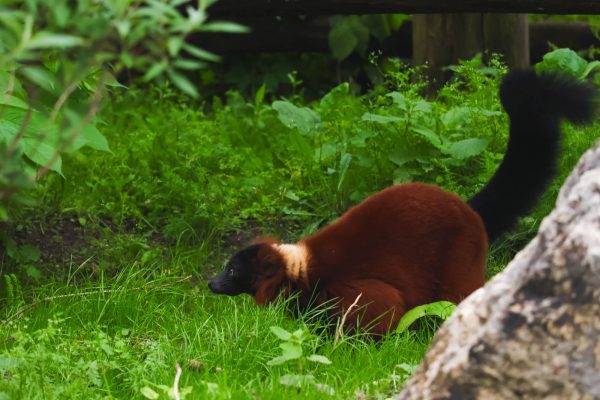
Red-ruffed Lemur
- Status: Critically Endangered
- Origins: Madagascar
- Location: Small Monkey Enclosure
Red-ruffed Lemur, residing in the rainforests of eastern Madagascar, blend seamlessly into the foliage due to their unique coloration, making them elusive and not well understood in their natural habitat. They are, however, known for their distinctive calls that can range from soft notes to intense roaring, signaling their presence. Born with beautiful blue eyes, lemur offspring are nurtured in nests and are uniquely transported by their mothers using their mouths. By the age of 24 days, they begin to consume solid foods.
5. Asian Small-clawed Otter
- Status: Vulnerable
- Origins: South and Southeast Asia
- Location: Near Rainforest House
The Asian Small-clawed Otter, the smallest otter species, thrives in the diverse aquatic environments of South and Southeast Asia, including freshwater rivers, creeks, estuaries, and coastal regions. Unique among its kin, this otter has notably small claws that do not protrude beyond the tips of its fingers and toes, a trait that, along with its partially webbed feet, enhances its dexterity in handling prey and swimming. These otters weigh between 1 to 5 kilograms / 2.2 to 11 pounds and measure about 45 to 60 centimeters / 17.7 to 23.6 inches in length, with their tails contributing an additional 25 to 35 centimeters / 9.8 to 13.8 inches. Their diet is rich in crustaceans, mollusks, and small fish, illustrating their aquatic lifestyle.
Social and family-oriented, these otters form close-knit groups in Southeast Asia’s waterways. Their small, non-protruding claws and the male’s key role in nurturing the young—opening their eyes at 40 days and swimming by 9 weeks—highlight their specialized adaptation and strong family ties crucial for survival.

Pygmy Otters are native to the coast of Southeast Asia. Photo by Alis Monte [CC BY-SA 4.0], via Connecting Vienna
At Schönbrunn Zoo, the Asian Small-clawed Otters “Blanche” and “Squeak” reside in an enclosure mirroring their natural setting, promoting swimming, foraging, and play. This habitat not only fosters their well-being but also raises awareness about their Vulnerable status due to habitat loss, pollution, and illegal trade, emphasizing the need for conservation and habitat preservation.
6. Prairie Dog
- Status: Least Concern
- Origins: Grasslands of North America
- Location: Near South America Park
Prairie dogs, members of the rodent family with a squirrel-like appearance, are renowned for their sophisticated underground habitats in the vast grasslands of North America. These industrious animals construct elaborate burrow systems known as towns, which serve as safe havens from predators and play a crucial role in the ecosystem. Weighing between 1-1.5 kg / 2.2-3.3 lb and measuring about 30-40 cm / 1-1.3 ft in length, prairie dogs have a primarily herbivorous diet that includes seeds, grasses, roots, and occasionally insects. This diet not only sustains them but also aids in controlling vegetation growth, maintaining the health of their grassland home.
The social structure within prairie dog communities is intricate, with families grouping into close-knit units called coteries. These groups are bound by a complex communication network of vocalizations, signaling everything from predator threats to social interactions. Despite their classification as Least Concern on the Red List of endangered species, prairie dog populations are not without their challenges. They face threats from habitat loss due to farming and settlement construction, disease, and eradication efforts, which have led to significant declines in some regions.
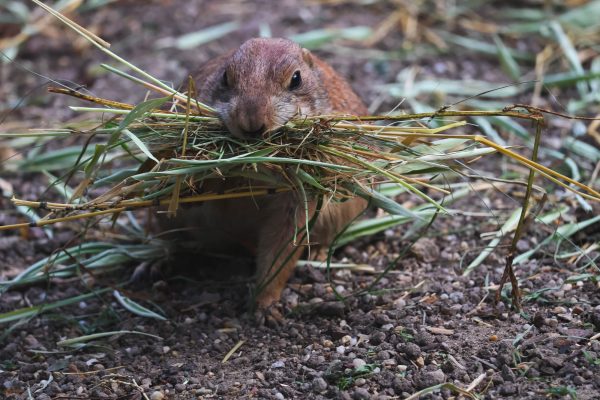
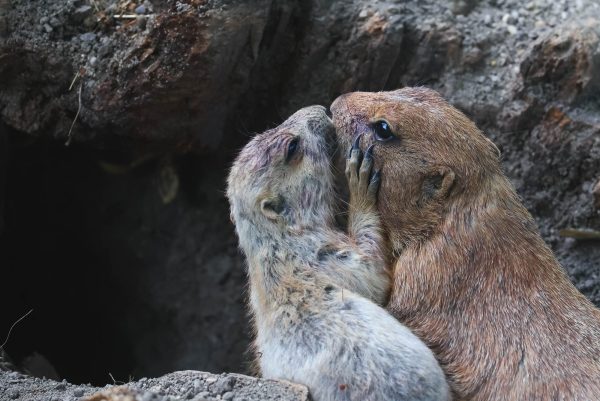
At Schönbrunn Zoo, the prairie dog exhibit meticulously recreates their natural grassland habitat, featuring an extensive network of tunnels and mounds that allow for natural behaviors such as burrowing and socializing. This environment not only ensures the prairie dogs’ well-being but also offers zoo visitors a glimpse into the complex world of these fascinating creatures. The only problem is Carrion Crows whose ever-present cohabitation these little creatures have to endure.
7. Pygmy Marmoset
- Status: Least Concern
- Origins: Western Amazon Rainforest
- Location: Monkey House
The Pygmy Marmoset, the smallest monkey globally, captivates with its diminutive size and vibrant expressions. Native to the Western Amazon’s rainforests, these primates are perfectly adapted to their arboreal lifestyle. Adults weigh between 100-150 g / 3.5-5.3 oz and measure 14-16 cm / 5.5-6.3 in, with tails adding another 15-20 cm / 5.97.9 in. Their specialized diet includes tree sap, gum, insects, and fruits, reflecting their unique ecological niche.
These monkeys thrive in rainforest fringes, using their claws to gnaw bark and feed on sap and insects. Living in groups of 2 to 15, only the dominant female breeds, typically producing twins, which emphasizes their complex social structure involving sophisticated communication through vocalizations and facial expressions.
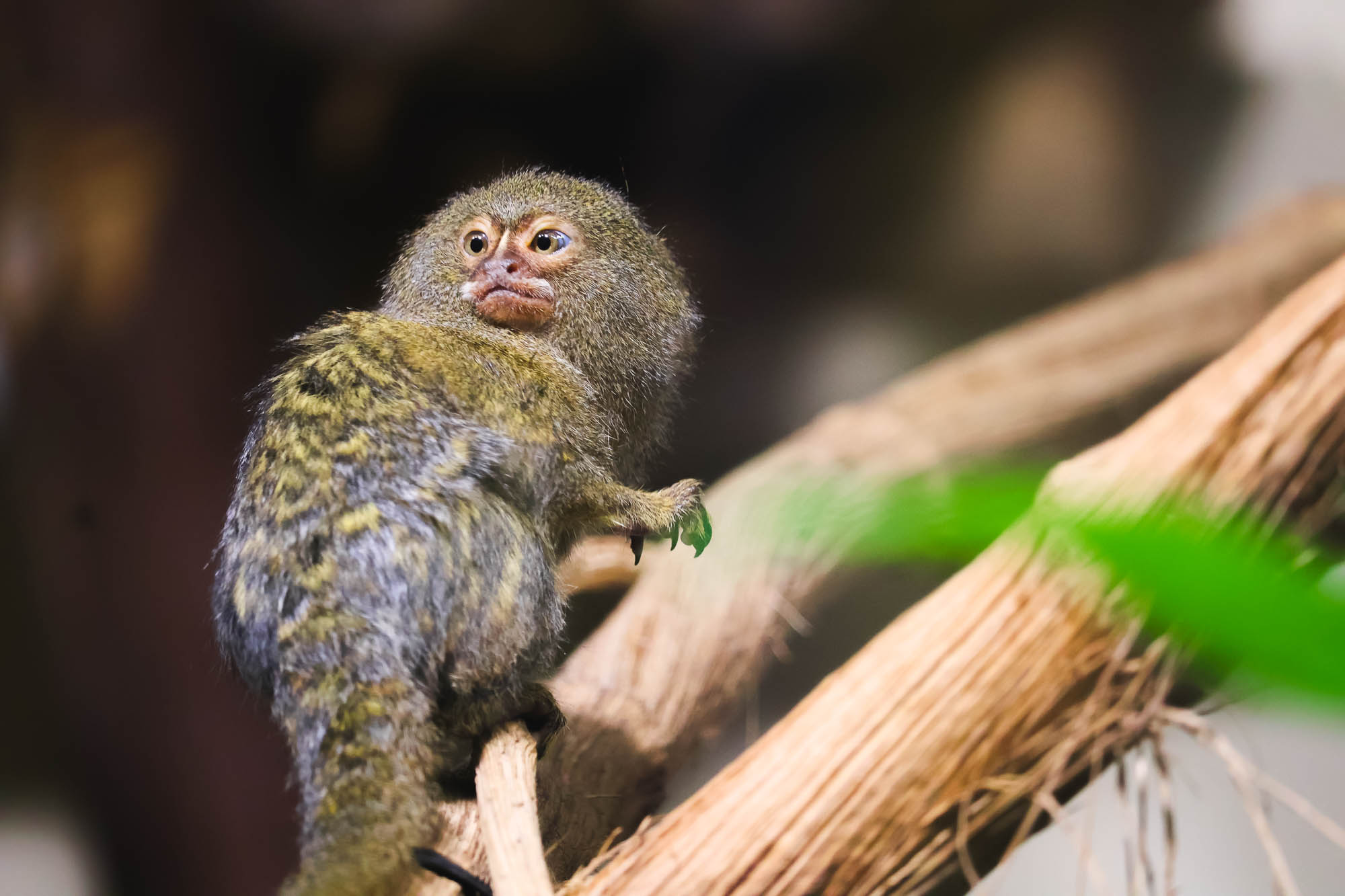
Pygmy Marmoset is the smallest monkey on the planet. Photo by Alis Monte [CC BY-SA 4.0], via Connecting the Dots
Despite being Least Concern, Pygmy Marmosets face threats from habitat destruction and the illegal pet trade. Schönbrunn Zoo’s enclosure mimics their natural habitat, allowing climbing, foraging, and socializing, which supports their well-being and educates visitors about their ecological role and conservation needs. The exhibit underlines the importance of Amazon rainforest biodiversity and the necessity of ongoing conservation efforts to protect these tiny monkeys and their ecosystem.
8. Southern Three-banded Armadillo
- Status: Near Threatened
- Origins: Central & Eastern South America
- Location: Monkey House
The Southern Three-Banded Armadillo is distinct for its ability to roll into a near-perfect ball as a defense mechanism – such an effective survival mechanism leaves them with few natural predators, with humans being one of the exceptions. It is a small armored mammal native to parts of South America, specifically the central and eastern regions. This species stands out not only for its unique protective shell composed of three movable bands but also for its diet that includes insects, particularly ants and termites, which it skillfully extracts with its long, sticky tongue. An adult Southern Three-Banded Armadillo typically weighs around 1-1.5 kg / 2.2-3.3 in and measures approximately 22-27 cm / 8.7-10.6 in in length, excluding the tail.
Unlike its more common relative, the Nine-Banded Armadillo, the Southern Three-Banded Armadillo prefers a solitary lifestyle, with habitats ranging from dry forests to savannas where it can burrow into the soil. Its armor, while providing significant protection against natural predators, cannot shield it from the threat of habitat loss and fragmentation, which are the primary concerns for its Near Threatened status.
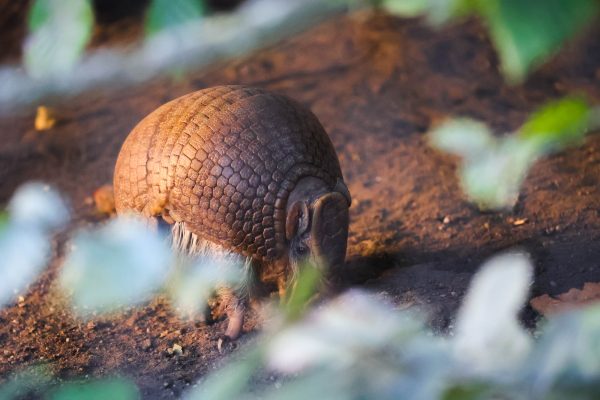

In Schönbrunn Zoo, the Southern Three-Banded Armadillo’s enclosure is designed to replicate the armadillo’s natural habitat, providing a mix of sandy and soil substrates for burrowing and areas for foraging to simulate natural behaviors. The exhibit allows visitors to observe the unique physical characteristics and behaviors of this armadillo, including its remarkable ability to roll into a ball.
9. Squirrel Monkey
- Status: Least Concern
- Origins: Tropical Forests of Central & South America
- Location: Monkey House
The Common Squirrel Monkey, a dynamic and vibrant primate, flourishes in the tropical forests of Central and South America. This species is distinguished by its eye-catching appearance, featuring an olive or yellowish coat on its arms and a white face framed by a black cap. Adults are notably small, with their weight ranging between 0.75 kg- 1.1 kg / 1.65-2.42 lb and a body length of about 25-35 cm / 9.8-13.8 in, while their tails extend an additional 35-42 cm / 13.8-16.5 in. The diet of these monkeys is mainly frugivorous and insectivorous, underscoring their importance in pollination and insect population control within their ecosystems.
Squirrel monkeys thrive in large, complex groups, communicating through a rich array of vocalizations and body language, and are skilled at navigating their tree environments with their long tails for balance. They engage in mutual grooming to strengthen social bonds and rest in communal spaces at night, underlining their group-oriented lifestyle. These primates stand out for having the highest brain-to-body weight ratio among all primates, showcasing their remarkable intelligence.


At Schönbrunn Zoo, the Common Squirrel Monkey’s enclosure has been thoughtfully designed to mirror the lush canopies of their wild habitats, with an abundance of trees and vines that promote natural climbing and leaping behaviors, as well as areas for socializing. This setup not only caters to the monkeys’ physical well-being but also engages their highly social and inquisitive natures, creating a stimulating experience for the animals and boy does it work – the Common Squirrel Monkeys are among the most active animals in the zoo, attracting many keen eyes.
10. African Pygmy Mouse
- Status: Least Concern
- Origins: Sub-Saharan Africa
- Location: Elephant House
The African Pygmy Mouse, known for being one of the smallest long-tailed mice, stands out with a length of just 5 cm / 2 in and a weight of 5 g / 0.18 oz, making it the tiniest rodent in Africa. These mice thrive in family units, are active during twilight and nighttime, and rear 2 to 4 young in shared nests. Their remarkable ability to construct elaborate tunnel systems within grassy habitats highlights their survival skills.
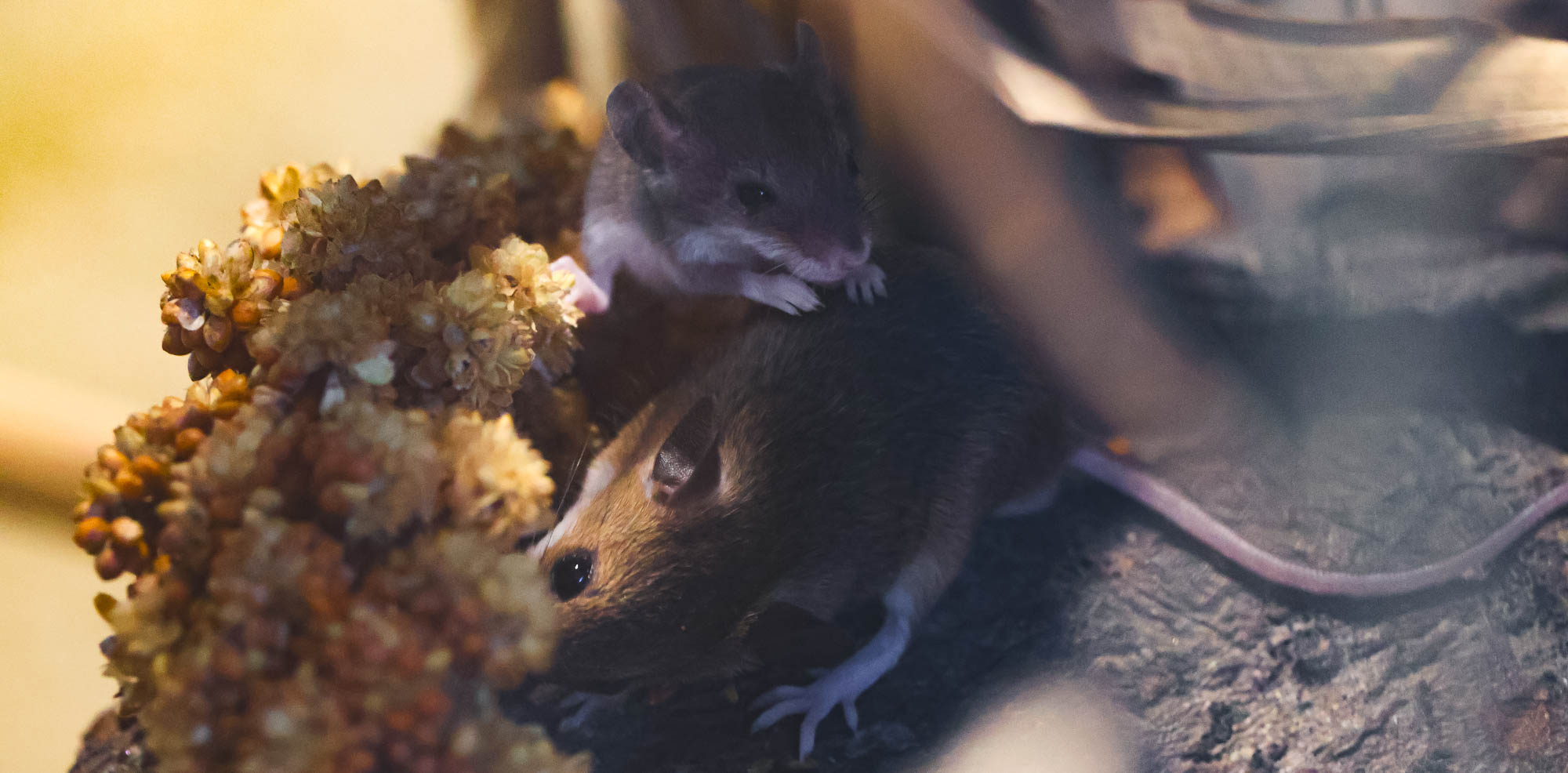
African Pygmy Mouse is the smallest rodent in Africa. Photo by Alis Monte [CC BY-SA 4.0], via Connecting the Dots
Adaptable to diverse African environments, their diet includes seeds, fruits, and insects, showcasing their versatility. The African Pygmy Mouse’s unique genetic makeup and efficient breeding strategies contribute to its resilience and ability to quickly recover population numbers, playing a crucial role in their ecosystem. This rodent exemplifies the significance of biodiversity and the complex interplay within nature, reminding us of the value and impact of even the smallest species on ecological balance.
Visiting the African pygmy mouse exhibit at Schönbrunn Zoo is a journey into the minute wonders of nature. It serves as a reminder that conservation efforts must encompass all creatures, big and small, to preserve the delicate balance of our planet’s ecosystems. The zoo’s dedication to these tiny ambassadors of the African savannah underscores the importance of every species in the tapestry of life, inviting visitors to marvel at the beauty and complexity of the natural world.
Map of Schönbrunn Zoo
Schönbrunn Zoo is located to the east of Hietzing (13th), to the south of Penzing (14th) and to the west of Meidling (12th). The 10 cutest animals are marked in yellow:
Buy Skip-the-line Tickets
To dive deeper into the history of Schönbrunn Zoo, discover animal feeding schedules, and pick up insider tips, don’t miss my detailed guide to Schönbrunn Zoo.